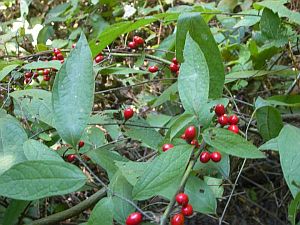Pondberry Federally listed Endangered
From NatureServe Explorer: Basic Description: A deciduous aromatic shrub 0.5-2 m tall, usually growing in large clonal clumps. The leaves smell like lemony-sassafras when crushed. Small pale yellow flowers bloom in early spring before the leaves have developed, and the bright red fruits often persist on the plants after the leaves have died in the autumn.. Flowering in March-April in the Carolinas; flowers in early spring, before leaves appear. Fruits mature on female plants in early fall, often persisting on the plant after the leaves have fallen. Dioecious (male and female flowers on separate plants). Habitat Comments: Can apparently occupy a variety of habitats as long as hydrological requirements are met. Occurs in seasonally flooded wetlands such as floodplain/bottomland hardwood forests and forested swales, on the bottoms and edges of shallow seasonal ponds in old dune fields, along the margins of ponds and depressions in pinelands, around the edges of sinkholes in coastal areas with karst topography, and along the borders of Sphagnum bogs. Usually in shade, but tolerates full sun.
The USFWS ECOS Species Profile: https://ecos.fws.gov/ecp0/profile/speciesProfile?spcode=Q2CO
The Alabama PCA has a Pondberry project in cooperation with the Alabama Forestry Commission.

